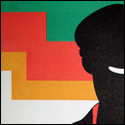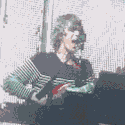|
mrbradlymrmartin posted:When you start fretting out* you need to replace your frets. Until then, a good buffing wont hurt. Next time you need to change strings, go ahead and take them all off and rub each fret with a green scouring pad and then wipe your fingerboard down with rubbing alcohol. That should smooth things out enough that you wont have any trouble bending. I get a little bit of buzz on most of the high E, but that extends beyond the worn frets (1-15), so I'm inclined to believe it's an action issue. The good news about the fret wear is that it's really even, which means I'm not unconsciously resorting to the same positions and keys all the time.
|
|
|
|

|
| # ? May 12, 2024 23:24 |
|
On the guitar: Has anyone got a good diagram showing a good pentatonic scale pattern that moves down the fretboard, rather than just across the strings? I know the pentatonic shapes, but I don't know a good way of chaining them together. I mean, I tend to switch up to the next shape only when I run out of scale when reach the top of the previous one, which, as I understand, isn't the most efficient position to change shape. While we're at it, a major scale pattern couldn't hurt either. I know one shape, again moving across the strings rather than up the fretboard, with the root note on the second finger and the hand position not moving. Hydrolith fucked around with this message at 02:02 on Jun 11, 2010 |
|
|
|
SlippyHat posted:Try panning the different instruments so that they occupy the space a little differently -- and think about three dimensional space, as well. Reverb and echo can move a sound forward and back in the mix, and will add depth. After that you can apply the EQ that bluestrat was talking about. SlippyHat's got a lot of good advice for you, and I agree with it except for this last sentence. If you are going for clarity, eq everything first, before panning and before adding much reverb or echo effects. Try to carve out the raw tracks, in mono, until they all complement each other and balance nicely. That's the best way to know what's REALLY fighting with whatever else. Then after you've got a balanced mono mix, do your panning and add your reverb effects for 3D depth and space. You don't have to do all your mixes with this method, but this is how you learn to get clarity/balance. If you start mixing by adding reverb and panning stuff you're burying (and making it harder to address) your real problem, which is eq. Address eq first and your mix will behave a lot better when you do the fun depth/space stuff.
|
|
|
|
CalvinDooglas posted:The good news about the fret wear is that it's really even, which means I'm not unconsciously resorting to the same positions and keys all the time.
|
|
|
|
Hydrolith posted:On the guitar: Has anyone got a good diagram showing a good pentatonic scale pattern that moves down the fretboard, rather than just across the strings? I know the pentatonic shapes, but I don't know a good way of chaining them together. I mean, I tend to switch up to the next shape only when I run out of scale when reach the top of the previous one, which, as I understand, isn't the most efficient position to change shape.
|
|
|
|
quote:The even better news here is that your fingerboard is in very good shape. Even a very slight bump left on top will get a fret or two wearing drastically faster. Hydrolith posted:On the guitar: Has anyone got a good diagram showing a good pentatonic scale pattern that moves down the fretboard, rather than just across the strings? I know the pentatonic shapes, but I don't know a good way of chaining them together. I mean, I tend to switch up to the next shape only when I run out of scale when reach the top of the previous one, which, as I understand, isn't the most efficient position to change shape. We could definitely chart something out here, but the best thing you can do is figure all the stuff out the hard way. No amount of memorization and jamming in keys will do as much as sitting there and working out your scales in every key and position. It's a chore, but once you do it a few times it starts to catch and your fretboard will really open up. I would also make a point of being able to think of your keys/scales in absolute terms, intervals and note names. Shapes are useful to a point, but they end up limiting your playing and boxing you in. Shapes are physical patterns that don't necessarily work out to make pleasant melodic patterns. You also run the risk of only gaining skill in transposing the licks you already play. It's good to know your stuff in every key, but you don't want to be stuck playing the same bluesy "A minor" type riff when someone gets funky in Eb. Knowing all the notes will make you more flexible when it comes to note choice in your leads, as well as help you come up with more interesting chord progressions. There's a lot of information and discussion about this stuff in the Beginning Guitar thread. CalvinDooglas fucked around with this message at 02:57 on Jun 11, 2010 |
|
|
|
I have been offered the below; ASHTON 4x10 BASS CAB - 400 Watts RMS - 4 x 10" Celestion Truvox Speakers - 8 ohm Impedance Now, I know nothing about Bass amps/cabs at all. So I was wondering, will that be powerful enough to jam with a 'heavy' band. And what sort of head will I need to get for that. Does the wattage on the head have any relevance to the wattage on the cab. etc. As you can see, I have no idea, any help would be appreciated
|
|
|
|
Popcorn posted:Can someone recommend a good tutorial on how to equalise tracks for a total beginner? I want to understand why all my recordings sound like muddy poo poo. I liked these guides when I was starting out too http://www.tweakheadz.com/EQ_and_the_Limits_of_Audio.html http://www.tweakheadz.com/perfect_mix.html
|
|
|
|
baka kaba posted:I liked these guides when I was starting out too Thanks! These look very readable. SlippyHat posted:Popcorn, I'd definitely mess around with your panning -- it sounds like everything is fighting for the center space. That said, this is loads better than my first recordings. Loads. Actually, everything in the track right now but for the drums is panned either left or right... but that doesn't mean they can't sound like they're fighting, of course! I think part of the panning problem here is that there's so many bloody layered guitars. quote:I'd also recommend compressing your tracks so that they sound a little more even (compression reduces the differences between the peaks and valleys on the waveform). An easy way to do this is with Levelator. Just drag an uncompressed track onto it and whammo: instant awesome. Yes, compression is something else I don't understand right now, and I know it's important. I know what it does in theory, but when I try compressing stuff I can never hear the difference.  I'll look into this 'whammo-enabling' Levelator, thanks. I'll look into this 'whammo-enabling' Levelator, thanks.quote:Other than that, did you record bass for those recordings? I couldn't hear it at all (which might just be my speakers). When I was making my first recordings, I never put much emphasis on the bass but it definitely fills out the sound. Nope, there's no bass. I did record a take on bass, but I find bass guitar especially hard to record for some reason. Likely my rubbish playing and rattly old bass guitar has something to do with it, but still... quote:Overall, this wasn't nearly as bad as you made it out to be. Nice work. Thanks, that's kind of you.
|
|
|
|
baka kaba posted:I liked these guides when I was starting out too No, on further examination I am too stupid for these. The first guide loses me the second he announces (without further explanation) 'The Audio Bandwidth=20Hz to 20kHz' then starts posting tiny diagrams that are meaningless to someone who doesn't even know what the gently caress a Hz is. I know I can look these things up individually but I'd like a nice, straightforward, cohesive guide for a total loving EQ/frequency newbie, that covers the basics in a nice orderly idiot's guide fashion.
|
|
|
|
Hz (Hertz) are cycles per second, 1000 of those is 1kHz (kilohertz). 20Hz is about the lowest frequency the human ear can perceive as pitch, 20kHz is roughly the highest. The article is listing those because in general any frequencies you want to cut or boost in a mix will lie within that range. Lower and it sounds like a series of clicks, higher and you'll just piss off your dog. Everyone's hearing is different though. The reason EQ id so complicated is that normal sounds contain many frequencies at the same time. This is probably not doing you a huge amount of good so let me look for a better internet resource.
|
|
|
|
Popcorn posted:No, on further examination I am too stupid for these. The first guide loses me the second he announces (without further explanation) 'The Audio Bandwidth=20Hz to 20kHz' then starts posting tiny diagrams that are meaningless to someone who doesn't even know what the gently caress a Hz is. I know I can look these things up individually but I'd like a nice, straightforward, cohesive guide for a total loving EQ/frequency newbie, that covers the basics in a nice orderly idiot's guide fashion. Have you ever messed with the EQ (or bass/treble sliders) on a stereo or an mp3 player? It's basically the same thing - the sounds we hear are from activity at different frequencies, from about 20 Hz to 20,000 Hz (20 kHz), which is around the range of human hearing. The lower frequencies are bassy, middle frequencies are more general, higher frequencies are things like cymbals - if you play with the EQ sliders on a stereo you can hear how the sound's being changed by boosting or cutting these general frequency ranges. So those images in the article are pictures of the sound if you like - the one you mentioned (beneath 'The Audio Bandwidth=20Hz to 20kHz') shows that that track has quite a lot of power around the 30Hz mark, on the left. That's definitely in the bassy area, and if you layer more bassy tracks on top of that the energy at those frequencies are going to stack up fast, and you'll get distortion (meaning you have to turn the tracks down) and clashing which will make the tracks indistinct - like two people talking over each other. If you read the rest of the blurb he explains why you want to cut those frequencies down, and you can see in the next images that he removes the really low frequency stuff on the left of the graph, but leaves the rest of it looking basically the same (i.e. sounding the same). This covers the same kinda stuff but it might be useful: http://www.jamcast.co.uk/eq-tips-a-basic-equalization-guide-part-one/ Don't get too hung up on the terminology either - you don't need to understand wave physics to accept that frequencies are the bassy, middy, trebly aspects of sound and that we talk about specific frequencies as a number followed by Hz. This might help out too - if you can load up a track in your recording software, and put a parametric EQ on there. Play the track, put the gain up on the EQ and mess with the Frequency control, listening to what part of the sound is getting boosted and emphasised. It'll sound weird with the gain up, but it'll give you an idea of what frequencies contribute to what part of the sound. Eventually you'll be able to use that to add more snap to a snare, or more breathiness to vocals and so on
|
|
|
|
I bought an acoustic drum kit a few months ago. Unlike my electronic kit I feel more comfortable playing with the hi-hats on the right instead of the left. Anyone know of a good remote hi-hat pedal/stand that works and can take a beating?
|
|
|
|
KenMornignstar posted:I bought an acoustic drum kit a few months ago. Unlike my electronic kit I feel more comfortable playing with the hi-hats on the right instead of the left.
|
|
|
|
CalvinDooglas posted:Are you left handed? if you're moving the hi hat it might just be easier go ahead and learn lefty, since that's about the biggest difference it makes in the kit. Im right handed. But it feels more comfortable to get harder hits if I have my hands open instead of crossed. I have tried keeping the hat on the left and playing regular open handed but I dont like keeping time with my left hand. Instead I moved the hats to the right and if felt great, so I stuck with that. Also gives me a nice quick switch to the ride and the crash on that side. I also play with a double bass pedal, so I need a remote stand that can go to the left of my second bass pedal. The only problem with the set up is its impossible to play the hats fast and drop to the snare for accents. So I dont do much of that on the acoustic kit. When I buy a remote pedal Im debating just getting a second pair of hats and moving the traditional stand back and running two sets of hats, at which point the remote pedal will go to the right of the left bass pedal.
|
|
|
|
KenMornignstar posted:Im right handed. But it feels more comfortable to get harder hits if I have my hands open instead of crossed. 
|
|
|
|
Col.Kiwi posted:This is not a good reason and what you're planning isn't a good idea. Post this setup in the drumming thread and people who know their poo poo will give you many reasons why Im relatively sure any long time drummer will tell me to set up my kit the way thats most comfortable to me. I can most comfortably do my normal hi hat work with the hats on the right. Regardess, this is still a hardware question, does anyone like the DW vs Pearl vs Yamaha stuff or should I try to find an old 2000 model Tama remote?
|
|
|
|
KenMornignstar posted:Im relatively sure any long time drummer will tell me to set up my kit the way thats most comfortable to me. I can most comfortably do my normal hi hat work with the hats on the right. eehhh, you should check out the drumming thread, if only because this is a fairly specialized gear question. Yamaha has excellent instruments all around - I own/have owned 3 Yahama guitars and a keyboard. They make everything, and well.
|
|
|
|
Hey guys, my band has a lot of programmed synth beats and layers in our album, do any of you know the best way we can get those to play live? We were just going to bounce them to one track on an ipod, but our drummer plays to a click track, so they wouldn't line up correctly. Thanks 
|
|
|
|
why in the hell do the new Hammond B-3s only have a MIDI out jack i mean, i can understand having only one midi jack on my boss sp-202, but i got that for under a hundred bucks, ffs
|
|
|
|
hey all, i would like to know what the following chords would be in drop D tuning.. eb-x Bb-7 Gb-9 Db-9 Ab-7 Eb-x notes in this are: Eb, Bb, and F eb-x Bb-0 Gb-0 Db-2 Ab-3 Eb-x notes: Cb, Eb, Gb, Bb (would this be a Cbmaj7?) thanks a bunch  ! !
|
|
|
|
|
dr. madlove posted:hey all, i would like to know what the following chords would be in drop D tuning..
|
|
|
|
dr. madlove posted:hey all, i would like to know what the following chords would be in drop D tuning..
|
|
|
|
baka kaba posted:EQ stuff OK, after reading this post and that link and mucking about in Cubase for a while, I'm starting to understand the concept better. Now a couple more stupid questions: 1) How do I open up a frequency graph in Cubase for a whole project? So I can see where all my frequencies is at? 2) In this tutorial, the guy demonstrates how he isolates individual frequencies to identify an unwanted noise in the snare recording. I understand that, and spent a while trying to do the same thing, but... I don't understand how he actually works out which frequency has the noise on it! When he shuffles around in the video, I can still hear the ringing noise, it just sounds like it's warping around. What is it about the particular frequency he settles on that makes it special?
|
|
|
|
I don't use Cubase but you could try the stuff mentioned in the grey box here http://www.soundonsound.com/sos/sep05/articles/cubasetech.htm As for the snare thing, it's not easy to hear this kind of thing at first. Basically (from listening to the before/after part at the end) he's trying to take out some of the bonk from the snare (the aspect that makes it sound like when the snare's off). Once you can tell which part you're listening for, you can tell that he starts sweeping up and down the frequencies listening for emphasis on the bonk - it gets a lot louder when he's in the right place. It really helps to know what you're listening for, because every frequency sounds important in some way  If you want something else to practice on, try a vocal track (even a spoken one) with some harsh sibilant S sounds, and try to find the frequency responsible for the harshness. Then you can cut the gain instead of boosting it, and find a setting that reduces the hissiness while still sounding natural
|
|
|
|
I'm trying to sequence MIDI drums in protools w/mbox 2. But I'm getting no sound and I have no idea where to begin troubleshooting. When I click the keyboard to the left of the regions I can see that there is a signal coming through. But no sound. I tried watching the DVD but he uses some plugin which I don't have. I tried looking it up online but all of the advice is for people using MIDI controllers, which I am not, I am using a pencil. Please help. 
|
|
|
|
I have a Vox AD100 Valvetronix head and it's been making a bunch of weird "siren" sounds. I cleaned out the fuse, then when that didn't help I replaced the fuse. I'm about to replace the 12ax7 pre-amp tube and somebody told me it should be a JDJ but the one I bought is a 7-Wa. I am retarded, so: is this just a stylistic difference or something that could damage my amp a lá different amperes, watts, ohms etc. ?
|
|
|
|
as long as it's still a 12AX7 of some kind you're probably fine. If you aren't sure to get, just get generic Groove Tubes. Regardless of brand, a huge number of tubes are made by just a few manufacturers.
|
|
|
|
Hey, I got a question. I don't really know much about instruments, but when I was a kid ~9-10 I got a Ludwig drumkit because I wanted to play. I kinda fell out of it and it's been sitting around for like 12 years. I'm trying to sell it, but I have no idea as to the value or how to go about selling them. Should I go to a musician store to try to sell them, or is that a ripoff. Craigslist? Some other site? I understand that it's hard to judge value of a kit over the internet, but like what kind of things should I look for in regards to selling points, I mean, I don't really know if ludwig is even that good, or what model it is. I'm going to take pictures today if that helps, but I think I got them for somewhere upwards of $500, the kit includes a Snare, kick, rack and floor tom, highhat and a crash. Does that fact that its vintage add or detract value usually? Thanks for the help, I'll snag some pics in a bit.
|
|
|
|
You mean like from the 90's? I don't know that 90's counts as vintage for drums yet. Ludwigs are good though, so that shouldnt really hurt anything. I don't really know much about Id-ing or pricing drums though, sorry. Anyways my own question. I have a digitech RP350 guitar pedal that has USB out. Would plugging a bass guitar into this for recording hurt it in any way? I know you're likely to blow guitar amps that way, but I have no clue if it would be bad for circuitry. I can just listen with headphones as it records anyway.
|
|
|
|
Logic question: I broke dicked my ESX24 patch library (read: erased in a drunken stupor) in Logic Pro 9 and I was wondering if there were a way I could reinstall the patch library?
|
|
|
|
Is this worth buying?: http://cgi.ebay.com/ws/eBayISAPI.dll?ViewItem&item=280524011549&fromMakeTrack=true&ssPageName=VIP:watchlink:top:en I don't gig, but I used to bring my old amp over to my buddies houses to jam, haven't had a chance to do that since I got this new Blues Jr, and I plan on bringing it to my dorm in the fall, and who knows where else after.
|
|
|
|
not unless you plan on gigging or dont have a car. transporting an amp one way is pretty easy as long as you make sure its not gonna be sliding around a whole lot
|
|
|
|
Yeah no don't buy that if you aren't friggin touring. Unless you have no car and need to take your amp on public transportation or something. As long as you make sure nothing sharp can collide with the grillcloth its very easy to just toss an amp in your backseat/trunk leave it at that. I'm gigging locally and I don't have a case for my 1972 Ampeg V2 amp which I love dearly. It lives in the rehearsal space mostly and when I go to gigs/elsewhere it goes in my backseat or carefully packed in the van someplace that it can't slide around. I have had no troubles like this and don't lose any sleep over it. Amps aren't that fragile, as long as you don't abuse them you're good.
|
|
|
|
Watch out for the knobs, too. I've lost the exterior part of two pots in transit. Having a fixed master volume is kind of nice for tonal consistency, though.
|
|
|
|
If you want a little more protection than nothing but not as much as that thing look into a slipcover. Like this here: http://www.zzounds.com/item--FEN0050279000
|
|
|
|
This is a really stupid question, but how do I play my USB midi keyboard live through Windows 7? I had it connected to an Ubuntu computer and was using Qsynth. I rearranged my office and for now, it would be far less effort if I could just connect it to the Windows 7 computer, run some program, and play my keyboard and sound comes out. No recording or sequencing or anything fancy, I just want to play the piano. Bonus points if I can use Soundfonts.
|
|
|
|
Erwin posted:This is a really stupid question, but how do I play my USB midi keyboard live through Windows 7? I had it connected to an Ubuntu computer and was using Qsynth. I rearranged my office and for now, it would be far less effort if I could just connect it to the Windows 7 computer, run some program, and play my keyboard and sound comes out. No recording or sequencing or anything fancy, I just want to play the piano. Savihost (or its more advanced sibling VSTHost, on the same site) + sfz (VST soundfont player) + ASIO4ALL (low-latency drivers if you have a sound card without native ASIO drivers)
|
|
|
|
Does anyone have any tips on cheapy performance samplers? I mean something along the lines of an SP 404, but I can't really afford one- like the majority of musicians, I am poor. I don't need to do sample editing, its just for triggering stuff live- I don't have a laptop and I'm not exactly gonna drag my desktop around for gigs. So really I'm after something with a reasonable amount of sampling time, that uses an SD card or similar, and maybe has a couple of effects on it. I'm probably better off just saving up, but it's always worth asking!
|
|
|
|

|
| # ? May 12, 2024 23:24 |
|
The story is long and uninteresting/unrelated, but I've decided I should learn the Hurdy-Gurdy. While the Minstrel model from Olympus seems ideal, the pricetag of 2200$ is offputting. Since this will be my first attempt at it, I feel a 'budget' model is in order, a used one if I can find it. So far not much luck, anyone here got some words of wisdom on the matter?
|
|
|





















